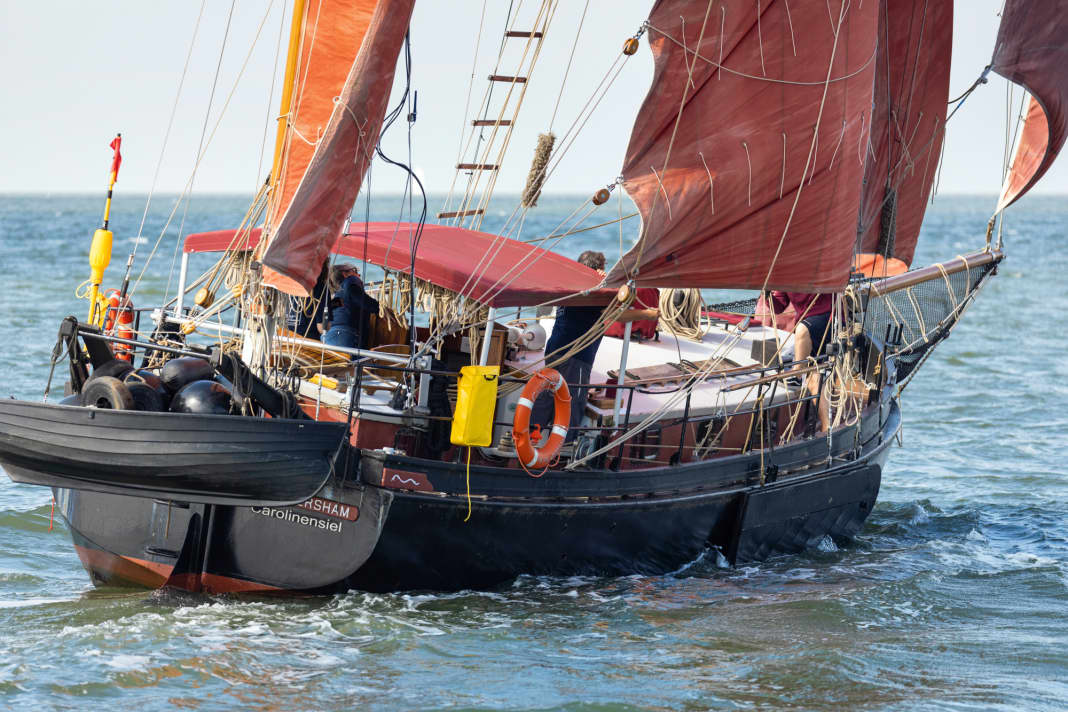





There is a hive of activity on board the "Gloriana of Faversham", which is waiting at a sheet piling in the harbour of Harlesiel in East Frisia for her show run. She has only just been fitted with a new mast and the mainsail has taken its place on the gaff again. Not all the ropes with which the rectangular red cloth can be reefed like a curtain are in the right place. One of them flies out and flies through the air at a height of three metres. Skipper and owner Markus Seebich quickly boards the wooden steps on the shrouds, where he can climb up to the donkey's head on the main mast. He grabs the line and threads it in. "That's one of the special features of this boat: the fact that you can do almost everything yourself and without much effort," says Seebich, citing a major practical advantage of the boat, which is supposedly quite awkward to handle.
At 19.20 metres in length overall and weighing 25 tonnes, she is a little sister to the traditional flat-bottomed "Thames Barge" workboats. These travelled between the European mainland and England when freight was still transported under sail around the turn of the last century.
With a draught of less than a metre, they could penetrate far into the rapidly silting, tidal rivers. Nevertheless, they were sufficiently stable in weight to safely cross the sometimes quite rough English Channel. The crew of just two shared the limited space in the aft peak, while the rest of the space was loaded up to the roof.
"Gloriana" fascinates, then as now
The idea of travelling the world's oceans safely in a spacious boat and discovering places that most sailors are unable to due to the draught, all with a traditional British look, appealed to an English businessman so much that he commissioned the construction of a smaller and much more comfortable version of these sturdy workboats at the end of the 1980s. Designer and yacht builder Paul Winch from Faversham in the British county of Kent took on the task. He drew up detailed plans and laid the keel of the "Gloriana" in 1988. The hull alone, made of six millimetre thick shipbuilding steel, a twelve millimetre thick keel plate and four bulkheads, two of which are collision bulkheads, speaks of the great plans and high standards of the first owner.
A small boy with big eyes stands by his father's hand on the quay wall. He can't be moved until the heavyweight has cast off. Tourists pause, pointing upwards to the mast with retractable stays or the jib boom with net, where you can rest leisurely and close to the waves while travelling. "You're never alone on this boat, passers-by always stop to have a chat and ask lots of curious questions," reports the skipper's son, before taking up his position on the spring and waiting for the 99 hp of the Perkins engine to steam the yawl in. The standing gaff with the mainsail hoisted against it offers the fresh wind plenty of surface to attack. Even the large outer harbour of Harlesiel can quickly become narrow; a small foretaste of the powerful thrust we are to get outside.
As a partner of the Wadden Sea National Park, "Gloriana" sometimes has inexperienced guests on board
Most of the time, the 50-square-metre main stays stowed in the aft peak. A detailed reefing plan provides for sailing under full sail - 145 square metres of cloth - up to a maximum of eleven knots of wind. Today, with a good 15 knots, it should still stand. Originally sailed with a main boom, the foot has been running free for several years. "Without a boom, sailing with inexperienced co-sailors is safer and reefing is quick and uncomplicated," explains Seebich. As a partner of the Wadden Sea National Park, he occasionally has paying guests on board who are not necessarily experienced sailors. He takes them on mudflat hikes, harbour porpoise watching or diving expeditions off Heligoland.
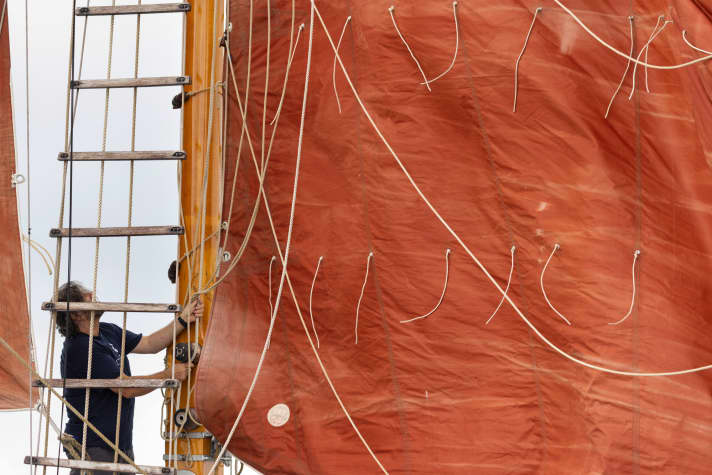
It is easy to imagine how inexperienced fellow sailors might fare when attempting to adopt confident sailing behaviour. From the tip of the jib boom to the clew of the mizzen sail, countless blocks, clamps, cleats and winches. Two masts, two gaffs, a boom, connected with hundreds of metres of halyards, sheets, ropes and reefing lines: It takes more than a day to get to grips with it all. The owner doesn't know how many metres of the polyester rigging with its traditional look run through blocks and over winches. He bought it in 200 metre rolls and cut it to length as required.
Sailing orders on "Gloriana" are unusual for yacht sailors at first
"It takes time to get to know everything about a boat like this and find the optimum sail trim for the different situations," explains Markus Seebich, who has owned the "Gloriana" since 2016 and is still discovering new things. Especially in the fine trim: from jib to mizzen sail, each individual cloth can be reduced several times with Bindereffs. This means that the Gaffelyawl can be sailed safely and stably at all times. Provided the crew know what they are doing. Today's crew consists of the skipper, his son Kennard and his girlfriend Paula Dietzel. Both rush across the deck when setting sail in narrow waters and give orders such as "jib sheet, mizzen sheet, jib halyard clear. Ready to hoist jib. Hot on the jib!", clearing halyards and sheets, taking the flystay down another turn on the way or banging on the water stay.
For ordinary yacht sailors, what is behind the respective order can only be harmonised with sensible actions through careful observation. Under almost full sail - the topsail has to do without its appearance today, it is only used at less than 4 Beaufort - the heavy ship starts up quite quickly. The log shows four, five, and with a little help from the tide, even more than six knots of speed.
All too soon, the old lighthouse of Wangerooge is abeam and a turn is on the programme. The classic wooden steering wheel with turned spokes, which seems almost tiny in view of the ship's dimensions, is light in the hand. For a moment, the "Gloriana" seems to refuse to co-operate and stand still. "But you notice immediately when she comes round, and then she's right back again," explains Kennard Seebich, "the jib is the main thing that helps." Flat as a flounder along its entire length with a draught of just 1.10 metres, the Yawl has very little drift.
Robust charm reveals the "work boat" category
Amongst the agile sports boats whizzing across the Wadden Sea on this summery day, the "Gloriana" has the robust and impressive charm of her sisters in the workboat category. Beneath the curved white superstructure, the black hull with its straight stem looks incredibly solid. This can give the impression that it is better not to mess with her, not even with the 75-kilo stick anchor hanging down vertically.
Curved golden inlays and the stern, on the other hand, which is narrow and modelled on a cut champagne glass, add a touch of elegance. This only becomes apparent at second glance, as a fixed dinghy, both also black, hangs from stately davits. A ladder has its permanent place on the railing. Owners and guests use it to disembark when the flat-bottomed ship dries out in the Wadden Sea. Not without first measuring the water depth in feet and fathoms with a plumb bob to ensure that the 42-foot underwater hull is as high and dry as possible.
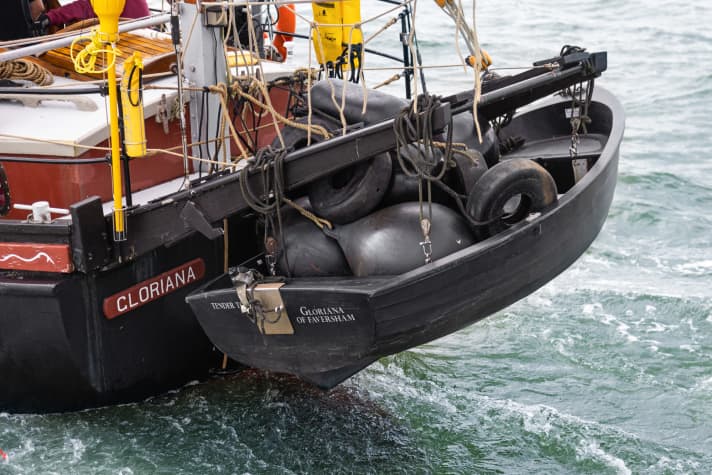
The centreboards, which are obligatory for a flat-bottomed boat, can provide a little more calm in a boat that is not exactly sailing nervously anyway. However, it has been proven that they are not absolutely necessary. One of the previous owners was so annoyed by their rattling noise on his Atlantic voyage that he sank them somewhere between the Canary Islands and Cape Verde without further ado.
Care-intensive "Gloriana" as a change from work
All masts and round timbers are made of Oregon Pine - including the newly built wooden mast, which shines in the sun, smooth, free of knotholes and accurately varnished. On deck, however, a never-ending to-do list is revealed: As soon as the jib, mizzen and gaff have been varnished, the blocks and fittings are queuing up. Treadmaster running surfaces need to be maintained and renewed, unavoidable traces of rust need to be removed and new paint is due here and there. Then there is the underwater hull, which also needs to be refurbished every two to three years.
It can easily take a whole day with a small crew until the sails are struck, halyards, sheets and lines are cleared and the "Gloriana" is brought from her resting position in the museum harbour of Carolinensiel into sailing mode. Why go to all that trouble when you could simply sail on a manageable yacht? "I'm a professional sailor and needed a new hobby," says sailing school owner Markus Seebich with a grin, sitting in his favourite spot, a rotating stool between the steering wheel and the companionway to the aft peak. From here, he has a view of the entire ship and can also see into the saloon, which gives an idea that he has probably fallen in love with this work boat for more than just the job.
Four steps lead down into the wide room with a standing height of 2.20 metres. Precious woods and metals shimmer cosily in the sunlight: mahogany furniture on the walls and ceiling panels made of pitch pine wood with paraffin lamps, storm glass, barometer and tide clock. Hundreds of bronze wood screws, each one countersunk in a small, round brass rosette, give the panels an accurate pattern; a deliberate design element and extremely practical at the same time, as each individual board can be easily unscrewed and inspected and replaced behind it.
Comfortable, sea-going yacht with the look of a workboat
The skipper takes a seat on the dog bunk at the spacious navigation table and pulls a drinks drawer out from underneath him. It can easily hold four times the size of a standard sherry compartment. Up to twelve people can be accommodated in the forepeak, dog berths and the owner's cosy aft cabin with bathroom, so there is plenty of storage space, as well as tanks for 1,000 litres of diesel and 800 litres of water.
A Swedish stove with squirrel relief heats the saloon and also a water pocket, from which the warm water circulates by gravity alone into a radiator in the aft cabin and - particularly cosy - through thick pipes behind the saloon bench. After a fresh day at sea, the soft, burgundy Chesterfield upholstery warms the bones. Briquettes and firewood can be conveniently stored in the bilge under the saloon floor, although this can only be moved with a little effort, strength and dexterity. After all, it is also made of solid iroko wood and laid as strip parquet. There is nothing to suggest that only goods were transported on the historical models of the "Gloriana" in this room. Their weight is replaced by twelve tonnes of concrete in the bilge, which give the gaffelyawl stability.
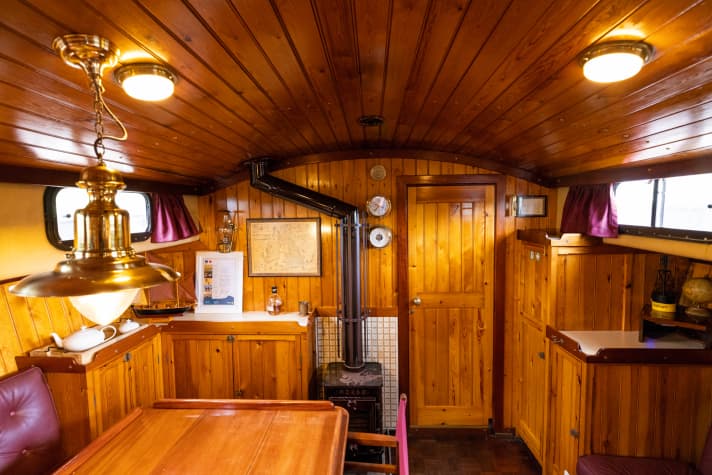
The first owner's precise ideas and the designer's meticulous realisation allowed the concept of a comfortable, sea-going yacht with the appearance of a working vessel to be realised. The British merchant sailed with her as far as the Cape Verde Islands and decided to stay there. The second owner also took the "Gloriana" on extensive Atlantic and Mediterranean cruises before selling her to an East Frisian in Mallorca, who brought her to her new home on the Wadden Sea.
Second life as a commercial boat
When Markus Seebich saw her for the first time in the Carolinensiel museum harbour in 2013, he said: "If this little black cargo ship ever comes up for sale, I want it!" Three years later, he took over the "Gloriana", a ship like no other. However, it was precisely this circumstance, in particular the first owner's extravagant wishes, that caused all calculations to get out of hand during her construction. When the "Gloriana" was launched three years after the keel was laid, designer and boat builder Paul Winch was broke and retired to private life. "However, I needed the plans for the Gloriana in order to register it as a commercial boat and could only track him down with a lot of research," says Markus Seebich. When he finally tracked him down, the now retired designer was not very fond of his work - the painful experience of bankruptcy was too deep-seated.
Nevertheless, a few good words and stories about the "Gloriana" later, he is ready to release his drawings. "Nothing on this ship - apart from the engine and the instruments - is off the peg. But I could have everything built one-to-one from these plans at any time," reports the owner with delight, showing a whole booklet of neatly handwritten and drawn plans at the saloon table, which leave out no angle, no screw, no halyard and no boom.
"Gloriana" can certainly be thought of as a long-distance driver
Meanwhile, in the choppy sea between Wangerooge and Spiekeroog, neither teacups nor glasses of juice slip on the ship, which is slightly over-rigged despite having a geared mainsail; only the two director's chairs at the saloon table can change position when the going gets tough. Despite some steep, small waves, the water rushes past the thick steel ship's side surprisingly quietly. It is easy to imagine sailing across the North Sea or Atlantic with the "Gloriana" even in stronger winds and waves without being exposed to the external noise. Especially as there are plenty of places to moor from the companionway to the forepeak, despite the spaciousness. For the time being, however, the tide forces the boat and crew to return to Harlesiel if they don't want to sit high and dry on the edge of the mudflats for a few hours.
During recovery, the mainsail dances like a dervish in a red robe and wants to flail about with blocks that the crew hold firmly in their hands. The wind keeps catching in smaller and larger pockets that form when reefing. In the narrowing mudflats with little room to manoeuvre, it seems unclear for a while whether the skipper will be able to conquer the sail or the sail will conquer him. "That's the reason why we only sail the main when there's little wind and always reef early with foresight," says the skipper, slightly out of breath.
Every move needs to be carefully considered
The lock to Carolinensiel has one last thrill in store, even for the obligatory onlookers at the top of the wall: a few decimetres of space remain fore and aft when the jib is raised. At 4.01 metres, the spreaders are as wide as the ship itself and just fit next to the porch of the lock keeper's house. Moving in, mooring lines on the bollards, stopping - every move needs to be carefully considered. At the berth in the museum harbour, the work continues: attaching fender boards and mooring lines, taking down and stowing all the sails.
All in all, wouldn't it make more sense to send the "Gloriana" on a long voyage in accordance with its original purpose? "Maybe, but that's not my dream," explains her owner. "At best, a trip to Faversham, her home, is very high on the wish list. Otherwise, I like being here on the North Sea and in the Wadden Sea, and she's the perfect ship for that."
Technical data of the "Glorianaof Faversham"
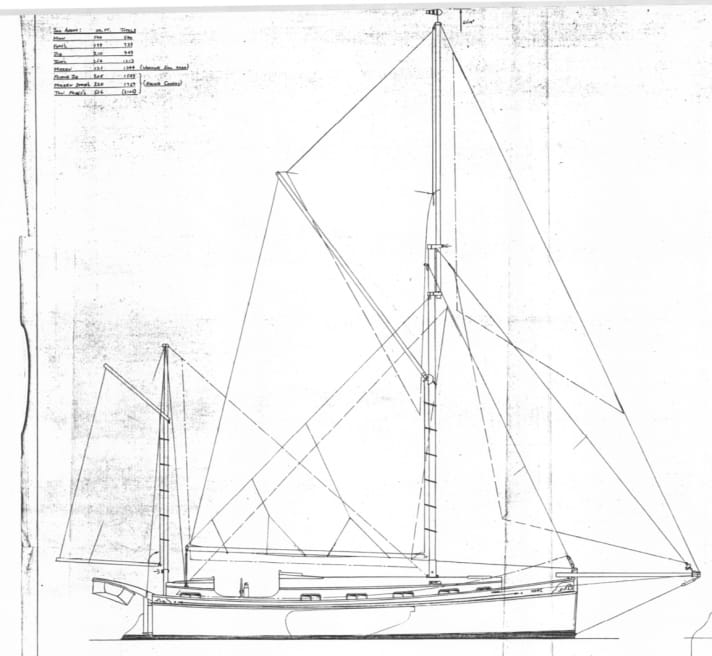
- Shipyard/year of construction: Paul Winch, Faversham/1988
- Building material:Steel
- Torso length:12,92 m
- Total length:19,20 m
- Width:4,01 m
- Depth:1,10-2,35 m
- Weight: 25,0 t
- Ballast/proportion:12,0 t/48 %
- Working sail area:125 m²
- Maximum sail area: 145 m²
- Sail carrying capacity:3,8
- Mast height above waterline:19,50 m
- machine (Perkins):99 HP

